Steve Green – Development of New Anti-Rollback Device Provides Pain Relief for Wheelchair Users
It is estimated that in the USA alone, over 2.7 million individuals require a wheelchair for mobility. By far the greatest fraction of manual wheelchair users rely on conventional manual pushrim drive wheelchairs, yet the use of such wheelchairs leads to well-documented shoulder injuries and chronic pain. We read here of how Steve Green of Green Technologies, Inc, is tackling this problem through the development and patenting of a wheelchair anti-rollback device that addresses these injury and safety issues with an innovative yet simple mechanism.
Health Challenges Caused by Prolonged Wheelchair Use
Steve Green is a university qualified mechanical engineer and has worked for 40 years in various industries. However, it was a chance invitation to a body builder competition for people with paraplegia that led to his ongoing commitment to the invention of improved devices to allow physically challenged people to better interact with their environments. He explains, ‘I am dismayed by the ubiquitous and unnecessary incidence of obstacles to mobility and basic activities of wheelchair users our society allows. As a mechanical engineer and small business entrepreneur, it is my joy and challenge to use my skills and the capabilities of my business to provide systems, devices, and solutions where possible.’
Wheelchairs in the modern form have been around since at least 1760, when John Joseph Merlin invented pushrim propulsion. The Merlin Chair, as it was called, bears a remarkable resemblance to wheelchairs today, despite the intervening 240 years.
The conventional pushrim operated wheelchair is now the most commonly used assistive care mobility device, due to its simplicity, low cost, and intuitive operation. However, there is a downside to these advantages, in that the kinematic design of manual wheelchairs (often referred to as the ‘geometry of motion’), leaves much to be desired.
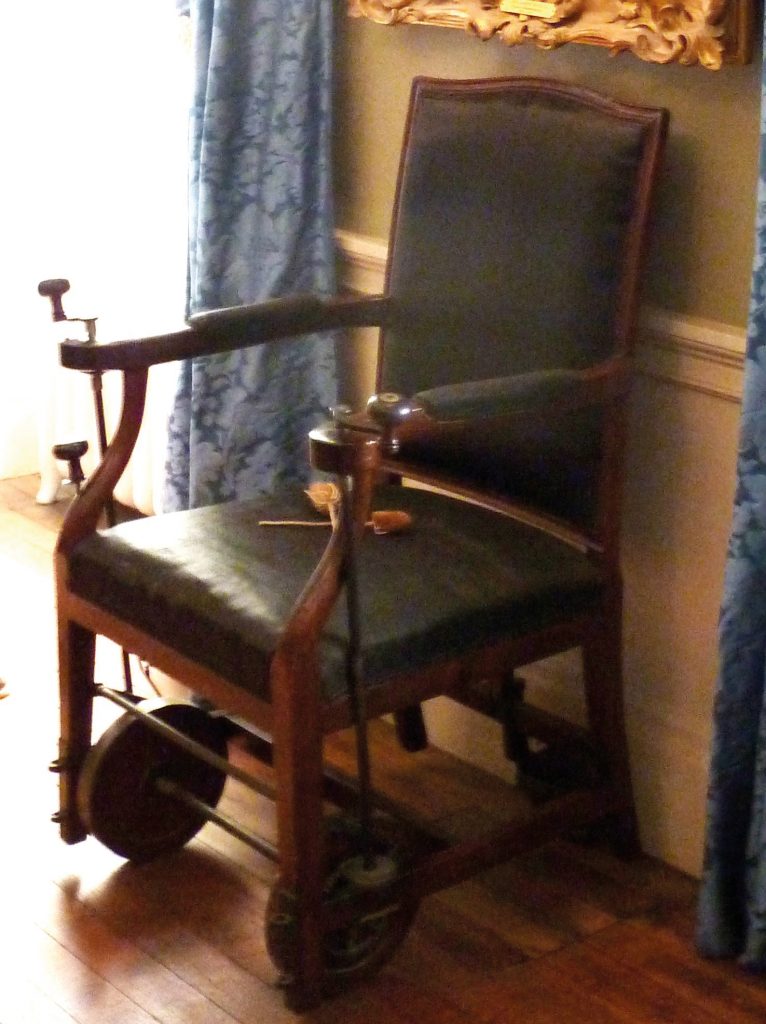
Example of an early wheelchair. Credit Steve Green.
Prolonged manual wheelchair use can lead to pain, repetitive strain injury and muscular damage, especially in the shoulder joints. The pain experienced tends to increase with the time spent using a wheelchair, despite the considerable improvements in wheelchair technology over the past 15 years. Degenerative changes occur from repeated use of the rotator cuff muscles, which can include wear and tear of the cartilage. The position and the repetitive loading of the shoulder joint for propulsion most likely contribute to these changes, along with muscle imbalance due to the mechanics of wheelchair propulsion.
An obvious problem that faces manual wheelchair users is that the world is not flat. Daily challenges include negotiating pavement curbs, street inclines, and building access ramps. For anyone who has experienced using a wheelchair, even a standard ramp with a 1:8 gradient provides significant difficulty. Only if the person propelling the chair has a healthy, strong upper body, is the challenge manageable.
Ascending a ramp with a conventional pushrim wheelchair requires a rapid ‘push and grab’ propulsion technique, which results in increased forces being repetitively imposed on the arms and shoulders. At the limit of the push stroke, the user is holding their weight, and that of the wheelchair against the force of gravity and physics, which is trying to make the chair roll backward. To propel further up the ramp, the user must release the pushrim and move their hands backward to a new position and grab the pushrim again. This motion must be accomplished very quickly, as the chair immediately rolls backward when they release their grip.
Many wheelchair users have various compounded diagnoses that impact their upper body coordination, and ability to grip. Whilst a person’s strength may be adequate, they may have conditions of spasticity and motor control which prevent accomplishing finely controlled arm and hand movements rapidly. It is these specific challenges that inspired Mr Green to seek a new and innovative solution to these long-standing issues.
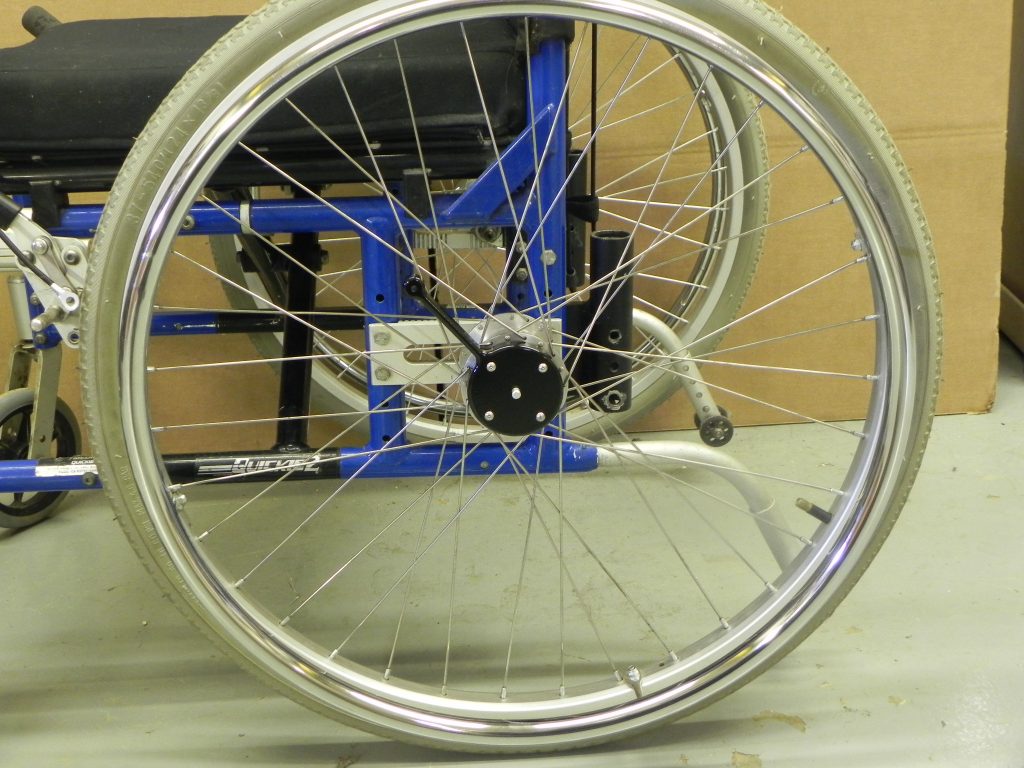
WARD equipped wheelchair. Credit Steve Green.
The Search for an Anti-Rollback Solution
Mr Green is the President of Green Technologies, Inc, a company which combines engineering capabilities with a complete machine shop, enabling him to offer concept design and prototyping services to a varied clientele. Along with new wheelchairs, he is currently designing apparatus for quicker detection of bacteria in food products, a radically improved archery bow for target shooters, and a water hydraulic servo mechanism for prosthetic fingers.
To address the fundamental flaws he noted in wheelchair design and use, Mr Green set out to find a solution that achieved exceptional utility, was safe to use, low cost, low weight and had a conventional appearance. As a result of his research and testing, the company has designed and patented a prototype wheelchair anti-rollback device (WARD), with a simple innovative mechanism which has selectable anti-rollback and freewheeling modes. The mechanism also allows complete manoeuvrability, including backward propelling, while in anti-rollback mode.
The need for anti-rollback functionality is not new and a search of the United States patent database turns up dozens of patents. The most commonly available solution is a kind of device often called a ‘hill holder,’ that basically uses a wedge attached to the parking brake lever that jams the wheel to prevent it from rotating backwards. Indeed, many varied anti-rollback mechanisms, wheels, and wheelchairs have been invented, yet none have captured a significant portion of the market, being too expensive or awkward to use.
In comparison testing of some of these devices to identify where improvements could be made, Mr Green determined that a typical ‘wedge type’ device will add about 20 to 25% to the user’s effort to propel the chair forward. The placement of the parking brake lever, which typically actuates hill-holders, often limits the forward push stroke of the handrim.
This additional effort while climbing a ramp must be considered in light of the potential user population with weakened strength or stamina. The Wheelchair Anti-Rollback Device (WARD), developed by Green Technologies does not add any extra effort to propelling up ramps, and enables the wheelchair user to rest at any time
‘I am dismayed by the ubiquitous and unnecessary incidence of obstacles to mobility and basic activities of wheelchair users our society allows. As a mechanical engineer and small business entrepreneur, it is my joy and challenge to use my skills and the capabilities of my business to provide systems, devices, and solutions where possible.’
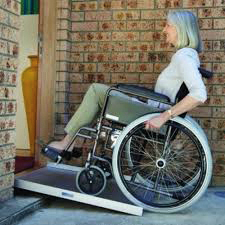
Wheelchair user on a ramp. Credit Steve Green.
Safety Issues a Concern
A safety issue shared by most anti-rollback mechanisms is that in restraining the propelling wheels from rotating backwards, it increases the potential for a backward rotating ‘wheelie’ and prevents the user from easily recovering from a wheelie. Clearly, when traversing an incline, the front of the wheelchair is higher, increasing the possibility of the wheelchair tipping backwards.
A second common shortcoming of anti-rollback inventions currently available, is that they are very difficult to shift back to ‘freewheeling’ mode when under the load imposed by an incline. Such a change is required if the manual wheelchair user (MWU) needs to reverse on the ramp before getting to the top, or even change direction to avoid an obstacle. Some hill-holder devices require that the wheelchair get to a level surface to shift, whilst others require that the user let go of the pushrims to operate the wheel lock (parking) brake levers before they can go backwards. If on a ramp, the wheelchair can roll backward, or turn sideways, before the user can grasp the pushrims again, posing a considerable risk to the user.
The inability to shift to neutral under load, and the critical safety issue of wheelie control, has resulted in anti-rollback mechanisms to this point having limited utility and imposing unnecessary risks.
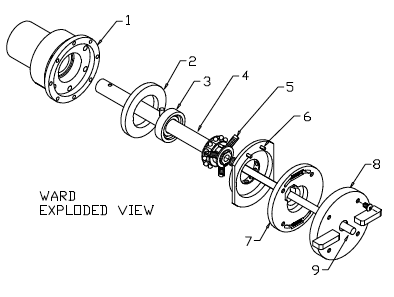
Credit Steve Green.
The WARD Concept
The team at Green Technologies is confident that they have simultaneously addressed the safety and utility issues posed by the existing anti-rollback devices. A demonstration of the WARD prototype operating on a ramp can be seen at the Youtube link: http://www.youtube.com/watch?v=LhXtyNhaVww.
There are three core innovative concepts which distinguish the WARD from other available solutions. By incorporating a unique adjustable ‘override’ clutch in series with an ‘anti-rollback’ clutch, it allows the user to instantly reverse at any time or under load on a ramp. These clutches operating in concert are the subject of a newly granted US patent. The dual mode anti-rollback clutch can be engaged or disengaged with a simple knob twist. Finally, the unique mode shift compensator spring mechanism that is incorporated into the clutch allows the user to rotate a selector knob from anti-rollback to freewheeling position, even when on a ramp and with the clutch itself locked into anti-rollback position by the load of the wheelchair.
If the MWU wishes to shift out of anti-rollback mode while on a slope, the shift knob will move into the detented freewheeling position, even whilst the clutch components are still ‘locked’. Thus, with the mechanism still holding the wheelchair, the MWU can release the pushrims, and use the mode knob to select ‘freewheeling’. The MWU can then, unhurriedly grasp the pushrims and make a slight forward propelling motion, which is sufficient to take the gravity load and allow the spring-loaded shift compensator to shift the clutch into freewheeling mode. Since the user’s hands are on the pushrims while this happens, there is no loss of control.
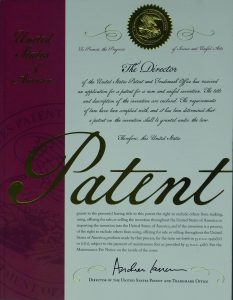
The unique adjustable override clutch allows the MWU to propel backward instantly, at any time, even when in anti-rollback mode if this manoeuvre is required. This override clutch is adjustable for holding torque level and is set slightly higher than that required to hold the total weight of the MWU and wheelchair on a standard incline. Thus, adding a slight rearward propelling motion will overcome the override clutch, allowing instant backward propulsion. This is, of course, an important safety feature for controlling wheelies, but is also of great utility in allowing quick directional control movements that are intuitive in the normal manner.
The WARD concept development was supported by Phase 1 and Phase 2 SBIR (Small Business Innovation Research) grants from the National Institutes of Health. These grants allowed Mr Green to engage the Human Engineering Research Laboratories of the University of Pittsburgh to comprehensively test WARD enabled wheelchairs under laboratory and daily life conditions. These formal tests demonstrated not only a significant reduction in wheelchair user reported pain while negotiating ramps, but enthusiastic user reactions to the WARD device. The data collected included push dynamics and user outcomes measures allowing correlation of the operation of the device with user reported pain.
Reference
https://doi.org/10.33548/SCIENTIA469
Meet the researchers

Steve Green
Green Technologies, Inc
West Fork
Washington County
Arkansas, AR
USA
Steve Green graduated from the University of Arkansas, USA, as a mechanical engineer. After graduating, he began employment at Fiat-Allis Construction Machinery, Inc, where he designed and prototyped hydraulic steering systems for large earthmoving equipment. Between 1978 and 1994, Steve Green worked for BEI Motion Systems Co, where he designed the Star Selector Servo Sub-System angular encoders for the famous Hubble Space Telescope. Since 1994, Steve Green has been President of Green Technologies, Inc, a concept to production prototype development service. His organisation provides engineering and prototype fabrication services supporting medical and diagnostic device development to start-up businesses, providing specialist services in mechanical design, engineering, and fabrication. Mr Green holds several patents on a machining centre and milling systems design, granted since his formation of Green Technologies, Inc. His inventions have been awarded multiple National Institutes of Health Small Business Innovation Research (SBIR) grants.
CONTACT:
E: sgreen@greentechnologies.com
FUNDING:
R43AG042664-01; Completed; A Wheelchair Anti-Rollback Device; Principal Investigator: A research project to design, fabricate, and user test a mechanical system that allows improved control of a manual wheelchair on slopes and ramps.
R43HD044271-02; Completed; A Manual Standup Wheelchair; Principal Investigator: A research project to design a standup wheelchair that is totally manual in both propulsion and erection.
HD043516-02; Completed; A Modal Reciprocating Pushrim Drive Wheelchair; Principal Investigator: A research project to design a wheelchair drive that will enable manual pushrim wheelchair propulsion without the need to grab and release the pushrim.
R43HD41272-02; Completed; An Improved Lever Drive Wheelchair; Principal Investigator: A research project to demonstrate the bio-mechanical advantages of an innovative lever drive for manual wheelchairs.

Creative Commons Licence
(CC BY 4.0)
This work is licensed under a Creative Commons Attribution 4.0 International License. 
What does this mean?
Share: You can copy and redistribute the material in any medium or format
Adapt: You can change, and build upon the material for any purpose, even commercially.
Credit: You must give appropriate credit, provide a link to the license, and indicate if changes were made.
More articles you may like
Dr Lifei Wang | Can Species Distribution Models Inform Us About Future Ecosystems?
The world is buzzing with news about how human activities and climate shifts are reshaping our ecosystems. Have you ever wondered how life will adapt to this rapidly changing world? Ecologists might be able to predict how different species will live in future using computer simulations. Dr Lifei Wang at the University of Toronto Scarborough investigates how different stimulations work under varying conditions to provide new insights into what may lie ahead.
Dr Yong Teng | Improving the Outlook for Head and Neck Cancer Patients
Dr Yong Teng at the Emory University School of Medicine is working with colleagues to overcome the high mortality of individuals diagnosed with cancers affecting the head and neck. One of his approaches is based on understanding the particular mechanisms of the ATAD3A gene, which new insights suggest are closely related to cancers affecting the head and neck.
Dr Tsun-Kong Sham – Dr Jiatang Chen – Dr Zou Finfrock – Dr Zhiqiang Wang | X-Rays Shine Light on Fuel Cell Catalysts
Understanding the electronic behaviour of fuel cell catalysts can be difficult using standard experimental techniques, although this knowledge is critical to their fine-tuning and optimisation. Dr Jiatang Chen at the University of Western Ontario works with colleagues to use the cutting-edge valence-to-core X-ray emission spectroscopy method to determine the precise electronic effects of altering the amounts of platinum and nickel in platinum-nickel catalysts used in fuel cells. Their research demonstrates the potential application of this technique to analysing battery materials, catalysts, and even cancer drug molecules.
Dr Michael Cherney – Professor Daniel Fisher | Unlocking Woolly Mammoth Mysteries: Tusks as Hormone Time Capsules
The impressive tusks found on proboscideans (the order of mammals that includes elephants, woolly mammoths, and mastodons) are like time capsules, preserving detailed records of their bearers’ lives in the form of growth layers and chemical traces. Frozen in time for thousands of years, these layers can unlock secrets about the lives of long-extinct relatives of modern elephants. Dr Michael Cherney and Professor Daniel Fisher from the University of Michigan used innovative techniques to extract and analyse steroid hormones preserved in woolly mammoth tusks. This ground-breaking work opens new avenues for exploring the biology and behaviour of extinct species.




